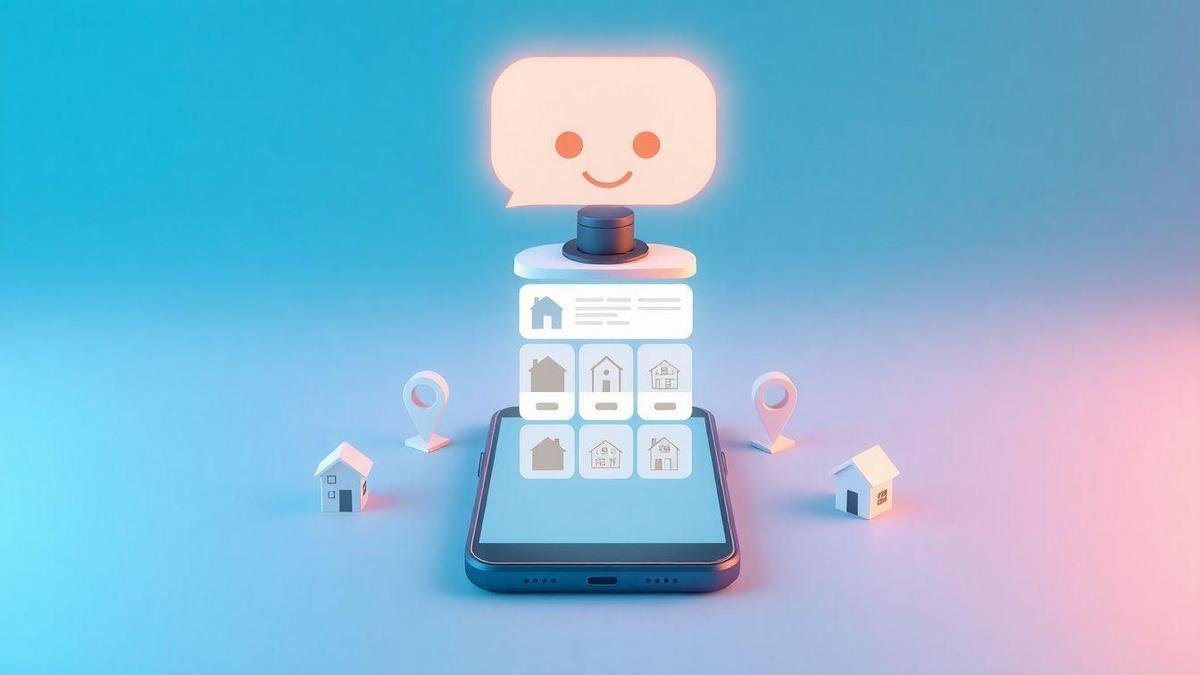Chatbots for real estate lead generation help agents respond faster and win more clients. They cut response time, boost contact capture, and use slot filling and minimal fields for better mobile leads. This article covers qualification scripts, intent recognition, and fast triage to route hot prospects. It shows how language AI and entity extraction personalize property picks, how automated booking syncs calendars, and how lead scoring and sentiment guide follow up. It ends with multilingual reach and privacy and compliance best practices.
Key Takeaway
- They answer leads instantly to capture interest.
- They ask short questions to qualify prospects.
- They schedule showings and update calendars.
- They personalize replies using user info.
- They transfer lead data to the CRM for follow-up.

Why Chatbots for real estate lead generation speed up response times
Chatbots for real estate lead generation act like a digital front desk. They greet visitors the second a page loads, turning casual browsers into captured leads before interest cools. For an agent, that first contact is gold — a quick reply can make the difference between a booked tour and a missed opportunity.
They handle the small, time‑eating tasks that slow humans down: answering price questions, showing photos, and booking viewings in seconds using simple flows and canned replies. That frees agents to focus on high‑value calls and in‑person tours while building trust through immediate, useful answers. A bot integrated with optimized website capture converts more of those page visits into contacts.
How conversational AI for real estate lead generation answers leads quickly
Conversational AI reads intent fast, spots whether a visitor wants a tour, more photos, or financing details, then routes the chat to the right path. Focused flows cut back‑and‑forth and give clear next steps in one or two messages.
The same bot works across website chat, Facebook, and WhatsApp, so a buyer who messages at midnight still gets a reply. Integrating chat across channels complements broader social media and outreach strategies. If a complex question appears, the bot hands it off to an agent with the chat history attached, preserving momentum and avoiding repetition.
Measured response time gains and their impact on conversion
In practice, bots move first responses from hours to seconds. Teams often see average first reply fall from several hours to under a minute, which increases live conversations, contact rates, and showings. Faster replies tend to increase conversion from initial contact to booked tours and lower cost per lead — measurable in standard conversion-rate and ROI metrics.
Quick reply scripts agents can use to capture interest
Short, friendly lines keep chats warm and move leads to action:
- “Hi, this is Maria from City Homes — interested in this listing or similar ones?”
- “Thanks for asking — would midday or evening work best?”
- “Great choice — I’ll send photos and a quick video now. Do you prefer email or WhatsApp?”
- “If budget helps, what price range should I look at for you?”
These tight scripts create clear next steps with a human touch.

How Chatbots for real estate lead generation increase contact capture on sites
Chatbots act like a friendly doorman on a property site. Instead of a long form, chat flows ask one small question at a time, lowering friction and getting more visitors to share contact details without feeling pressured.
Bots can tag preferences like budget and neighborhood while the visitor is still on the page, so the sales team receives warmer leads. A well-built bot turns casual browsing into a measurable contact-capture channel that works 24/7 — especially when paired with a mobile-first experience.
Comparing chat capture to traditional web forms for higher completion
Forms stack questions in a single block, which can scare users away. Chat capture breaks that block into short exchanges, skipping nonessential fields and asking only what moves the conversation forward. This reduces abandonment and boosts response rates, especially on mobile.
Using slot filling for property search chatbots to collect key data
Slot filling is the bot’s clipboard — budget, bedrooms, move-in date — collected one at a time. The bot remembers answers and fills search parameters so visitors get instant matches without retyping. Slot-filling and scheduling are common elements of broader marketing automation stacks.
Minimal field flows for better mobile capture
Minimal flows remove heavy typing and use quick taps: choices, sliders, or yes/no prompts. On phones, this feels like texting, not filling a form. Fewer fields mean faster completion and higher mobile capture.

Automating qualification with lead qualification chatbot scripts for realtors
Chatbots for real estate lead generation act like a friendly gatekeeper: they ask smart questions, capture details, and flag serious prospects. This saves time and boosts lead quality so agents spend more hours with humans who want to move forward.
A good script opens with purpose, asks the right follow-ups, and ends with the next step. Think of it as a short interview: polite, fast, and aimed at actionable data such as budget, timeline, and preferred neighborhoods. Integration matters — the bot should push answers into the CRM and add tags like “hot”, “follow up”, or “long-term” using standard CRM integration patterns.
Standard qualifying questions agents should include in scripts
Scripts should ask simple, direct questions that reveal intent:
- “Are you looking to buy or rent?”
- “What is your budget range?”
- “Which neighborhoods interest you?”
- “When do you plan to move?”
- “Are you pre-approved for a mortgage?”
If answers indicate tight timeframes and a matching budget, the bot flags the lead high priority; vague answers move the lead into nurture.
Intent recognition for property inquiries to route serious buyers
Intent recognition helps the bot read between the lines, catching phrases like “ready to close” or “want to see today.” A trained model or keyword rules spot urgency and financing status to route serious buyers to calls and casual leads to information flows. For deeper analytics and prediction, teams often combine intent models with predictive analytics to improve routing decisions.
Fast triage rules to send hot leads to sales reps
Set triggers: immediate handoff if the lead requests a viewing, budget matches listings, or they say they are pre-approved. Combine with time cues (move-in within 30 days). When a hot lead appears, send a short summary to the rep for fast, confident outreach.

Personalizing offers with NLP-powered personalized property recommendations
NLP lets agents serve personalized recommendations like a trusted matchmaker. It reads property descriptions, messages, and search queries, then finds features that matter — balconies, walk-in closets, or nearby schools. Chatbots for real estate lead generation use these signals to start conversations that feel human. Teams implementing this typically consult resources on AI in real estate sales to design ranking and matching rules.
NLP models rank listings by explicit wishes (budget, bedrooms) and implied tastes (style, commute), so agents show fewer, better options. That reduces overwhelm and raises engagement.
Entity extraction for property details to match preferences
Entity extraction turns text into tidy facts: room counts, amenities, materials, and location cues. It maps synonyms and typos (“one-bed” and “1BR”) to the same tag and flags numeric details like square feet and year built, improving match precision.
Using past interactions to refine suggested listings
Past behavior is a gold mine. If a prospect repeatedly clicks on lofts with exposed brick, the system weights brick and loft higher. Combine explicit feedback (likes) with implicit signals (dwell time, repeat views) and use recency rules so recent interest gets more weight.
Simple personalization rules that improve engagement
- Match at least two top preferences first
- Boost saved or repeatedly viewed listings
- Demote items explicitly dismissed
- Favor recent interactions over older ones

Booking visits with an automated appointment scheduling chatbot for property tours
An automated appointment scheduling chatbot greets leads, asks a few quick questions, and offers available times so leads move from browsing to visiting without long email threads or phone tag. This supports Chatbots for real estate lead generation by turning casual inquiries into scheduled tours and feeding appointments back into your marketing automation and CRM workflows.
The system works around the clock, keeps the pipeline warm, and writes bookings back into the CRM with contact records, tags, and tour times — giving managers data to refine follow-ups and marketing.
How calendar sync and availability checks reduce back-and-forth
Calendar sync shows only open slots, handles time zones, buffers between tours, and blocked dates. When a prospect picks a time, the bot books it instantly, reducing double-booking and manual coordination.
Confirmation and reminder messages that cut no-shows
A confirmation message with address, meeting point, and the agent’s contact reassures visitors. Reminder SMS or WhatsApp messages (e.g., 24 hours and 1 hour before) with Confirm or Reschedule buttons reduce no-shows. These reminders tie into broader email and messaging sequences for higher attendance.
Sample booking prompts that streamline tours
- Which day works best: weekday or weekend?
- Pick a time: 10:00 AM, 2:00 PM, or 5:00 PM.
- Do you want a virtual tour or an in-person visit?
- How many people will attend?
- May I have your phone number to send a confirmation?
- Would you like a reminder 24 hours or 1 hour before the tour?

Prioritizing prospects with chatbot lead scoring using conversational data
Chat-based scoring turns chat logs into a priority map. When a chatbot captures a prospect’s words, it collects signals like intent, budget range, and move timeline, then sifts those into a lead score so teams know who to call first. Chatbots for real estate lead generation fit naturally into this flow because they capture intent in real time.
A good model treats each message as a clue: clear asks (e.g., “can I tour on Saturday?”) get big boosts while vague replies get low weight. Blend behavioral cues (clicks, pages viewed) with conversational cues (questions, urgency) so scores reflect real interest.
Which chat signals to use for score models
Focus on signals that show intent and readiness: explicit questions about availability, budget ranges, timeline phrases (“this month”), contact sharing, message length, response speed, and clicks on listings.
How to push scores into CRM for agent follow-up
Make the CRM the single source of truth. When the chatbot assigns a score, push a small payload: lead score, top chat cues, timestamp, and suggested action. Map chatbot fields to CRM fields, set triggers for routing (e.g., score > 80 → instant call task), and log transcript snippets for context — following best practices from CRM integration guides.
- Map chatbot data to CRM fields (score, cues, contact).
- Create routing rules tied to score bands.
- Auto-create tasks or notifications for agents.
- Store transcript snippets and timestamps.
Score bands to flag high, medium, and low opportunity leads
- High (80–100): Call within 30 minutes; priority task
- Medium (40–79): Email/SMS within 24 hours; schedule follow-up
- Low (0–39): Add to drip; review after property updates

Nurturing relationships using sentiment analysis for real estate lead nurturing
Sentiment analysis reads tone, mood, and urgency from messages and chat logs to help teams send the right message at the right time. If a lead sounds excited, move fast with clear next steps; if hesitant, slow down and offer reassurance. A chatbot can flag mood and log it for the agent so the human reply fits the person. These signals feed into adaptive nurture flows used in nurturing sequences and remarketing programs.
Detecting buyer mood to tailor follow-up tone and timing
Use cues like words, punctuation, emojis, and response speed. Tag these signals and score mood to tell the agent whether to be upbeat, patient, or urgent.
- Positive: “Love it!”, fast replies, emojis → Fast, direct CTA within hours
- Neutral: Short replies, no emotion → Informative, next-day touch
- Uncertain: Questions, “maybe”, delays → Reassuring, gentle check-in ~48 hrs
- Frustrated: ALL CAPS, expletives, long delays → Calm, immediate human contact
Automated sequences that adapt to positive or negative sentiment
Design flows that bend with mood. For positive sentiment, ramp up: quick tour offers and tight CTAs. For negative sentiment, slow and add empathy: apology, clarification, and offer a phone call. Detect mood, select the sequence, insert human handoff if needed, and log outcomes to refine messages. These adaptive campaigns work well alongside remarketing and targeted outreach.
- Detect mood and score it.
- Select the sequence: accelerate or soften.
- Insert human handoff if negative or high value.
- Log outcome and refine messages.
Escalation triggers when conversations show frustration
If a chat shows repeated negative language or explicit requests for a supervisor, raise a flag. Send a high-priority alert and a suggested script so an agent can call promptly, offer a clear next step, and document the resolution.

Expanding reach with a multilingual real estate chatbot for global buyers
A multilingual chatbot greets visitors in their native tongue, asks quick qualifying questions, and books viewings. Chatbots for real estate lead generation catch interest at odd hours and pass good leads to the team, expanding markets without stretching human resources. Multilingual capabilities should be part of broader digital marketing strategies for international listings.
Train the bot on local phrases and market terms so responses feel natural. Feed answers into the CRM, flag high-value leads, and hand off complex questions to humans.
Language detection and simple translation for early screening
Detect the visitor’s language, switch modes, and ask a few screening questions (budget, timeline, intent). Capture answers with a language tag for follow-up and confirm translations with a quick Is this correct? prompt. Flag nuanced or legal queries for human review.
Local cultural and legal notes to guide responses in each market
Use friendly, local phrasing and avoid promises that conflict with laws or market practice. Include short disclaimers and links to local rules where needed. Adapt contact preferences — phone or messaging apps — per culture.
Priority languages agents should support for international listings
Prioritize English, Spanish, Portuguese, Mandarin, Arabic, French, and German; add Russian or Hindi as demand dictates.

Building trust and compliance for Chatbots for real estate lead generation
Trust wins deals. A chatbot must be clear about who it is and what it will do with personal details. When a visitor shares address or budget, the bot should state data use, offer a simple consent option, and promise a human handoff if needed.
Compliance is a necessity: map rules like GDPR and CCPA to bot actions — what fields the bot asks for, how long it stores answers, and who can read transcripts. Limit stored data, log access, and give easy deletion options. Train staff, run audits, and build a fast human fallback when intent confidence is low.
Data privacy, consent, and secure storage best practices
Consent should be plain and active: the bot asks permission, states what it will store, and provides a toggle to accept or decline. If declined, the bot remains helpful but limits data collection.
Technical safeguards: encryption in transit and at rest, role-based access, MFA, retention and deletion policies, and consent records with timestamps. Automatic deletion after a set period and an easy delete my data option reduce legal exposure.
Key technical controls:
- Encryption (TLS for transit, AES for storage)
- Role-based access and MFA
- Retention and deletion policies
- Consent records with timestamps
- Regular backups and secure key management
Reducing bias in intent recognition for property inquiries
Bias arises from narrow training data. Mix data from varied neighborhoods, price ranges, and buyer types. Perform label audits, add synthetic examples for underrepresented cases, and use confidence thresholds with human handoff when needed — approaches commonly discussed in AI and analytics resources.
Steps to reduce bias:
- Audit labels and demographics monthly
- Add synthetic and rare-case examples
- Use confidence thresholds and human handoff
- Track performance by neighborhood and property type
Audit logs and record keeping for regulatory checks
Log consents, full chat transcripts, timestamps, IP/device markers, and edits. Keep an immutable trail for the legally required period and anonymize older entries. Searchable logs help answer complaints and show compliance to regulators.
ROI and metrics: how Chatbots for real estate lead generation pay off
Measure first response time, contact capture rate, showings scheduled, conversion from lead to tour, and cost per lead. Track score-to-conversion by band and channel. Typical wins include faster pipeline velocity, higher contact rates, more booked tours, and lower acquisition costs — all driven by consistent, immediate engagement the bot provides. Tie chatbot metrics into broader channels like PPC, email, and retargeting to see full funnel impact.
Conclusion
Chatbots act as a digital front desk that turns casual visits into captured leads. They cut response time, raise contact capture, and use tight flows like slot filling and minimal fields to win mobile prospects. Short, focused scripts and fast triage keep conversations moving; intent recognition, entity extraction, and lead scoring help teams find warm prospects quickly. Automated booking and calendar sync remove back-and-forth while NLP and sentiment signals make outreach feel human. With multilingual reach, clear privacy practices, and human fallbacks, chatbots become a growth engine — not a liability.
Explore related practical guides on lead generation tools, AI in real estate sales, CRM integration, marketing automation, and website optimization for leads for next steps.

No responses yet